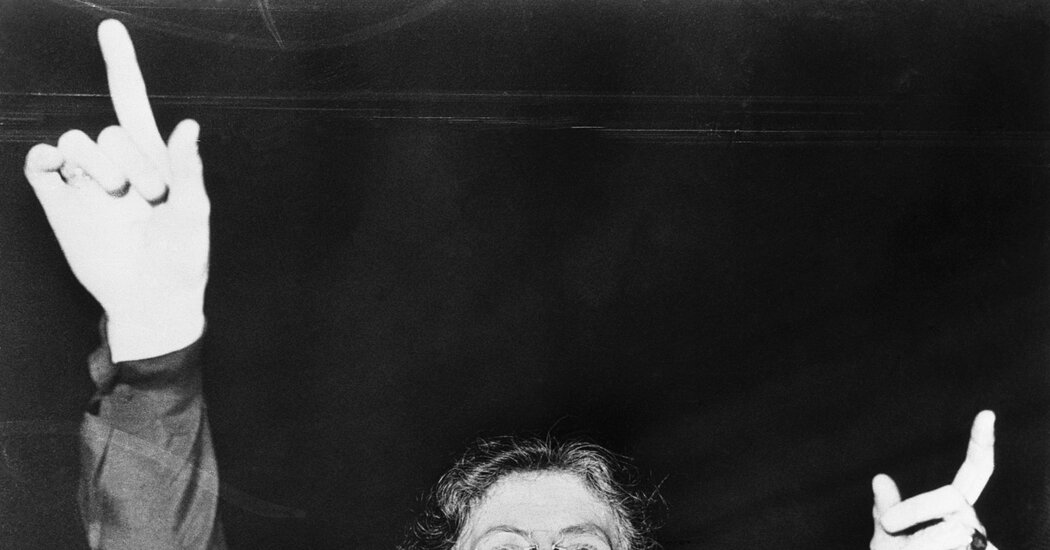In March 1912, the famous violinist and composer Eugène Ysaï visited his fellow musician Raoul Punio at his home in Paris. Pugno played and sang on the piano the opera “La Ville Morte” which he wrote with Nadia Boulanger, who was 35 years his junior.
“For this very personal performance,” Ysaye wrote to Boulanger later that month, “I have been left with the deepest and happiest impression.” He told her that the opera “is so Beautiful, so wonderful, so poignant”.
“La Ville Morte” is Boulanger’s most ambitious project in his young composition career. As it took shape, and the piano-vocal score was completed that summer, she wrote under the final bar: “Hallelujah!!!”
But one after another events prevented “City of Death” from making it to the stage. In 1914 Pugnaud, a key partner in selling it to the public, died. The outbreak of World War I delayed the planned premiere, not for the last time. A few years later, Boulanger’s dear sister, composer Lily Boulanger, also died, and Nadia almost stopped writing or promoting her own music.
Instead, Boulanger went on to become one of the greatest music teachers in history, to such 20th-century giants as Aaron Copland and Elliott Carter, as well as Quincy Jones, Burt Bacharach and Philip Glass and other important figures in the legend.
Boulanger, who died in 1979 as a composer, has had little discussion of his work, and La Ville Morte is more of a footnote than a true feat. The complete score is lost and has never been performed in the United States; it was not performed until this century. But on Friday, it will have its U.S. premiere at NYU Skirball in a Catapult Opera production with new orchestral arrangements and conductor Neil Goren. Neal Goren said it was “extremely rich and gorgeous.”
“I didn’t know Boulanger had written an opera before,” says Catapult founder and artistic director Goren. “I was completely fascinated by it. It was like Parsifal and Pelléas combined.
Boulanger and Punio wrote the script based on the play “La Città Morta” (La Città Morta) by the famous Italian writer Gabriele d’Annunzio, which was translated into French in 1898 as “La Città Morta”. La Ville Morte arrives in Paris, starring Sarah Bernhardt.
After Boulanger graduated from the Paris Conservatoire in 1904 at the age of 18, Punio remained the main supporter of her career. They met when she was a student and their relationship was both friendship and romance.
It’s unclear when they began considering “La Ville Morte,” but the scholars writing in the 2020 anthology “Nadia Boulanger and Her World” — including Alexandra Laederich and co-authors Jeanice Brooks and Kimberly Francis — were among those who wrote about Boulanger Letters and diaries long unavailable. An entry from May 22, 1910 reads: “We wrote the first notes of ‘La Ville Morte’.”
Details about the opera’s origins are unclear, especially regarding the division of labor. That speaks to what a true collaboration it was – but it also illustrates that in the early stages of Boulanger’s career, the music world took Boulanger less seriously than Pugno. She was building a respectable catalog of chamber and orchestral works but relied on Punio’s reputation to generate interest in “La Ville Morte.”
Ledrich described the first manuscript of the piano-vocal score as “a precious source in which one could clearly distinguish two types of handwriting, which always overlapped and complemented each other.” But Pugno did not give it to the masses Leave such an impression. Léonie Rosenstiel, in her biography Nadia Boulanger: A Musical Life, recounts his 1912 interview with Ward Stephen in The Musician In an interview with Ward Stephens, when asked what he was doing, he replied: “I’ve been extremely busy this summer. Writing an opera.” He did not mention Boulanger anywhere.
She was occasionally dissatisfied with D’Annunzio and Punio because they seemed inconsistent with her ambitions and desires to complete La Muerta. Brooks and Frances discovered a contradictory entry in her diary:
Went to Pugueno – with a bit of sadness and explanation – confessed my complex emotions consisting of pride as a woman, pride as a lover and sadness as an artist – but this gratitude, tenderness and decisiveness were not enough to make things right It gets worse, then, those rare and unforgettable moments – the sincerity, the emotion, the devotion – the huge emotion that unites us – it’s incredible.
Pugno and Boulanger worked together to bring “La Ville Morte” to the stage. They played the score together, both singing at the piano. It was rumored to premiere at the Paris Opéra, but it ended up at the Opéra Comique, where its leading figure, Pierre-Barthélemy Gheusi, scheduled it for a 1914 release. Early that year Pugna fell ill and died at a concert in Moscow. After the outbreak of war, Gruusi canceled all productions and continued to serve in the French army.
After the war, he was fired from the company. D’Annunzio no longer invests in “City of the Dead,” and other supporters of the work are no longer alive. Although Boulanger later spoke unfavorably about her work, her conduct towards the opera speaks for itself. She befriended the young Leonard Bernstein and gave him a copy of the score. (Not sure if it was the piano or the full version.) He expressed interest in performing, but didn’t pursue it.
G. Schirmer published the piano and voice score, which was Goren’s first exposure to the opera. He was asked to commission an arrangement; Joseph Stillwell and Stephan Cwik, with the help of former Boulanger protégé David Conte, produced one for 11 players.
Beyond the music, however, the opera needs work, said Robin Guarino, director of the production of Catapult (which was first staged at the Greek National Opera earlier this year). “There were redundancies in the text and some basic editing had to be done,” she said. “If there was a world premiere, Boulanger himself would do it.”
After the opera, Guarino found herself surprised by everything she saw and heard, a mysterious and dramatic story that unfolded with a wealth of gorgeous poetry in which, she said, “feminism burned hot beneath the surface.”
Listeners will hear music reminiscent of Debussy and Wagner, as well as Rachmaninov and Stravinsky, Goren said. There’s even some original jazz. “You can hear everything about that period reflected in this score,” he added. “There are basically two types of composers: synthesizers and innovators. I want people to think of her as a serious, effective composer because she is the supreme synthesizer.




